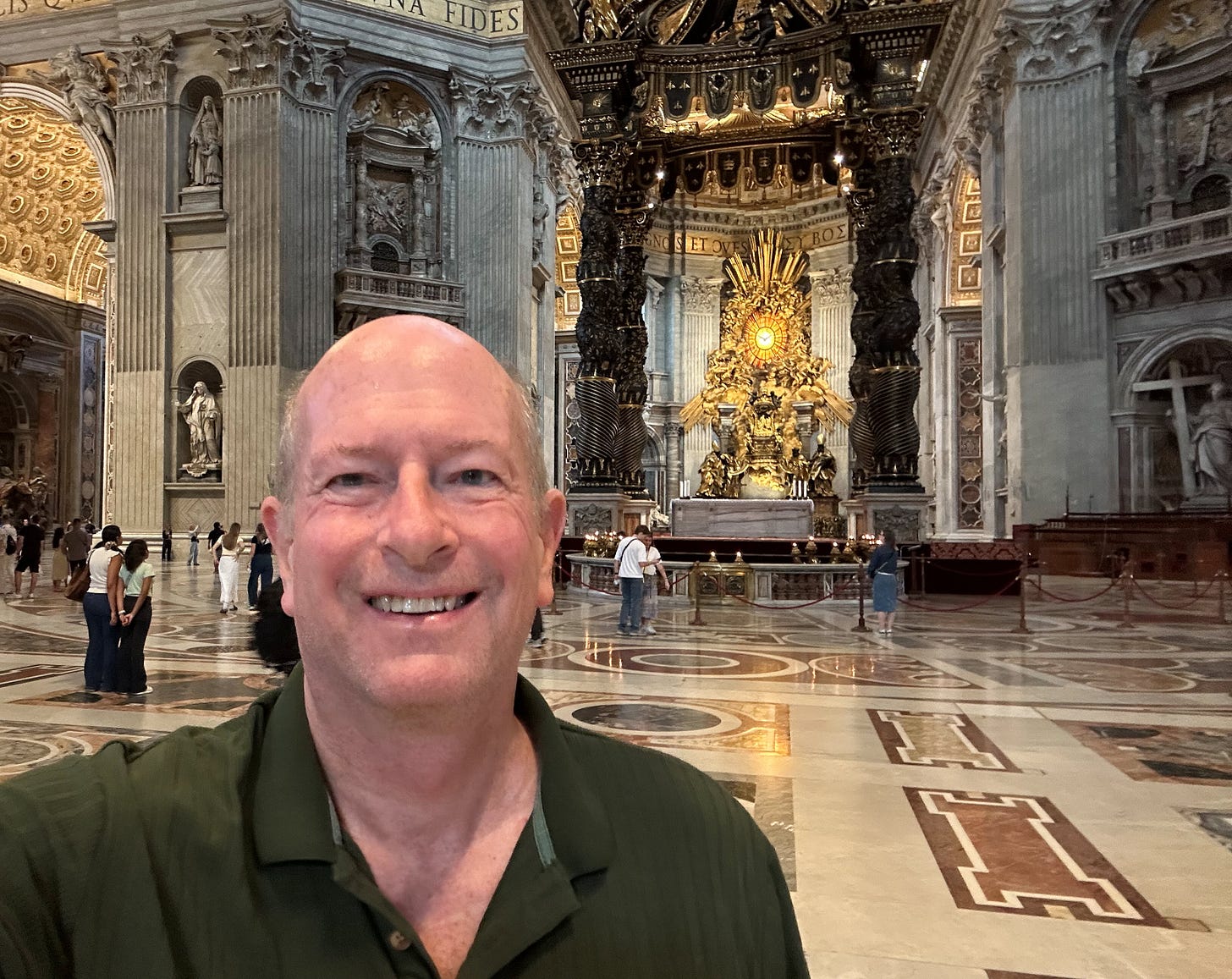Hey everybody. One of the reasons Rome is so absolutely mesmerizing—and why everyone should make the pilgrimage at least once—is because you’re not just visiting one city.
You’re experiencing two complete civilizations layered on top of each other like some incredible historical sandwich.
There’s Christian Rome, the realm of the Vatican with its soaring basilicas and countless churches.
And then there’s Roman Rome—the Rome of the Caesars, the gladiators, the empire that once ruled the known world.
Behind me in the video is the magnificent statue of Marcus Aurelius, one of the truly good Roman emperors.
This bronze masterpiece has quite the story.
I first stumbled upon it back in 1979 or 1980 during my initial Roman adventure, and it absolutely captivated me.
The last time I visited, it had vanished, whisked away for restoration and tucked safely inside some museum.
But now it’s back where it belongs, back in its original spot, and seeing it again felt like greeting an old friend.
Marcus Aurelius represents something profound about Rome’s dual nature. He was a Stoic philosopher — emperor, virtuous and contemplative, ruling at the very moment when pagan Rome was beginning its slow transformation into what would become Christian Rome.
As he himself wrote in his Meditations, he embodied the Roman ideal of duty and virtue that would later find new expression in Christian Rome.
This statue sits in the heart of Roman Rome, practically next door to the Forum where Julius Caesar’s body was burned after his assassination.
You can see those imposing statues of Roman senators looking down, and everywhere those four letters that define the Roman spirit: SPQR — Senatus Populusque Romanus, “The Senate and People of Rome.”
These letters are literally everywhere in the city, even stamped on modern manhole covers, because they represent something that never really died.
But here’s what’s remarkable about Rome. You can’t walk fifty feet without crossing from one civilization to the other.
The Romans themselves understood their city’s grandeur.
Emperor Augustus famously boasted, “I found Rome a city of bricks and left it a city of marble.”
By 117 AD, their empire stretched across the entire Mediterranean and beyond, with Rome as its beating heart—the first city in history to exceed one million residents.
The monuments they left behind still take your breath away. The Colosseum, seating 50,000 screaming spectators, remains the ultimate symbol of Imperial might.
Saint Venerable Bede captured its significance perfectly: “Rome will exist as long as the Colosseum does; when the Colosseum falls, so will Rome; when Rome falls, so will the world.”
Walking through the Roman Forum, you’re treading where senators debated the fate of empires. The Pantheon, dedicated around 126 AD to all the gods, still boasts the world’s largest unreinforced concrete dome nearly 2,000 years later—a testament to Roman engineering genius.
Then came the seismic shift.
In 312 AD, Emperor Constantine had his vision at the Battle of Milvian Bridge—”In this sign (the Cross) conquer”—and everything changed.
The Edict of Milan in AD 313 granted religious freedom, and suddenly temples were becoming churches. By AD 380, Christianity was the official state religion under Theodosius I.
Christian Rome rose from the ashes of persecution to become the spiritual capital of the world. St. Peter’s Basilica, built over the site of St. Peter’s martyrdom, became the world’s largest church and the heart of global Catholicism.
Mark Twain perfectly captured its majesty: “From the dome of St. Peter’s one can see every notable object in Rome… a panorama that is varied, extensive, beautiful to the eye, and more illustrious in history than any other in Europe.”
The Vatican Museums now house the world’s richest art collection, including Michelangelo’s breathtaking Sistine Chapel.
The city boasts over 900 churches—from the grand basilicas like Santa Maria Maggiore to tiny neighborhood chapels, each preserving centuries of faith, art, and history.
What fascinates me most is how these two Romes don’t just coexist—they’re completely intermingled. The Pantheon itself tells this story: originally dedicated to all the Roman gods, it was converted to a Christian church in 608 AD when Emperor Phocas donated it to Pope Boniface IV. Same building, completely different spiritual universe.
The great filmmaker Federico Fellini understood this perfectly: “In ‘Roma,’ I wanted to get across the idea that underneath Rome today is ancient Rome. So close. I am always conscious of that, and it thrills me.”
That’s exactly what you feel walking these streets.
You’re literally walking on layers of history, with pagan grandeur and Christian splendor sometimes occupying the very same stones.
Today, Rome draws over 10 million visitors annually, with the Colosseum attracting 7.7 million and the Vatican Museums over 6 million. Each visitor experiences what Goethe meant when he wrote, “Only in Rome is it possible to understand Rome.”
As Lord Byron called it “the city of the soul,” Rome remains what it has always been—Caput Mundi, the “Capital of the World.”
Whether you’re drawn to the echoes of gladiatorial combat or the whispered prayers of pilgrims, you’ll discover that in Rome, yesterday and forever meet in every single step.
Robert J. Hutchinson is the author of numerous books of popular history, including Searching for Jesus: New Discoveries in the Quest for Jesus of Nazareth (Thomas Nelson), The Dawn of Christianity (Thomas Nelson), The Politically Incorrect Guide to the Bible (Regnery) and When in Rome: A Journal of Life in Vatican City (Doubleday). Email him at: roberthutchinson@substack.com









